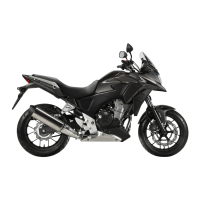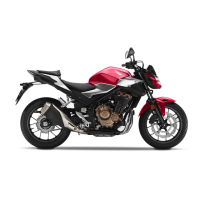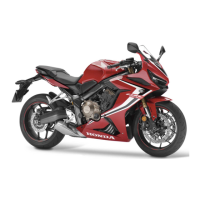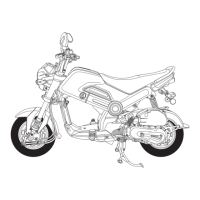Do you have a question about the Honda CB500X 2019 and is the answer not in the manual?
Guidelines to enhance rider safety, including inspections and precautions.
Information and warnings provided on labels on the motorcycle.
Essential precautions for safe riding, including protective apparel.
Guidelines for safe operation, including break-in period and braking.
Advice on adding accessories or making modifications to the motorcycle.
Guidelines for safely carrying luggage and cargo on the motorcycle.
Identifies the location of various parts and components on the motorcycle.
Explains the motorcycle's instrument panel, indicators, and controls.
Covers procedures for starting the engine, shifting gears, and refueling.
Information on helmet holder, tool kit, and document bag locations.
Explains why regular maintenance is crucial for safety and performance.
Outlines the recommended maintenance intervals and tasks.
Covers essential practices like pre-ride inspections and periodic checks.
Details procedures for battery cleaning, charging, and replacement.
Instructions for checking, adding, and changing engine oil and filter.
Covers checking brake fluid, pads, and adjusting the brake light switch.
Guidance on checking tire pressure, inspecting for damage, and wear.
Addresses problems when the engine fails to start or operate correctly.
Explains causes and solutions for engine overheating and gauge warnings.
Details the meaning and action for various warning lights like oil pressure and MIL.
Procedures for repairing tire punctures and removing wheels.
Covers issues like dead battery, burned-out bulbs, and blown fuses.
Information on ignition keys, VIN, and engine serial numbers for identification.
Guidelines for cleaning, polishing, storing, and transporting the motorcycle.
Details on emission systems, catalytic converters, and compliance.
Information on warranty coverage, recommended service, and dealer contact details.
Guidelines to enhance rider safety, including inspections and precautions.
Information and warnings provided on labels on the motorcycle.
Essential precautions for safe riding, including protective apparel.
Guidelines for safe operation, including break-in period and braking.
Advice on adding accessories or making modifications to the motorcycle.
Guidelines for safely carrying luggage and cargo on the motorcycle.
Identifies the location of various parts and components on the motorcycle.
Explains the motorcycle's instrument panel, indicators, and controls.
Covers procedures for starting the engine, shifting gears, and refueling.
Information on helmet holder, tool kit, and document bag locations.
Explains why regular maintenance is crucial for safety and performance.
Outlines the recommended maintenance intervals and tasks.
Covers essential practices like pre-ride inspections and periodic checks.
Details procedures for battery cleaning, charging, and replacement.
Instructions for checking, adding, and changing engine oil and filter.
Covers checking brake fluid, pads, and adjusting the brake light switch.
Guidance on checking tire pressure, inspecting for damage, and wear.
Addresses problems when the engine fails to start or operate correctly.
Explains causes and solutions for engine overheating and gauge warnings.
Details the meaning and action for various warning lights like oil pressure and MIL.
Procedures for repairing tire punctures and removing wheels.
Covers issues like dead battery, burned-out bulbs, and blown fuses.
Information on ignition keys, VIN, and engine serial numbers for identification.
Guidelines for cleaning, polishing, storing, and transporting the motorcycle.
Details on emission systems, catalytic converters, and compliance.
Information on warranty coverage, recommended service, and dealer contact details.
| Bore x Stroke | 67.0mm x 66.8mm |
|---|---|
| Compression Ratio | 10.7:1 |
| Fuel System | PGM-FI with 34mm throttle bodies |
| Transmission | 6-speed |
| Front Suspension | 41mm telescopic fork |
| Front Suspension Travel | 5.9 inches |
| Rear Suspension Travel | 5.3 inches |
| Rear Brake | Single 240mm disc with single-piston caliper |
| Front Tire | 110/80-19 |
| Rear Tire | 160/60-17 |
| Seat Height | 32.7 inches |
| Fuel Capacity | 4.6 gallons |
| Engine Type | 471cc liquid-cooled parallel-twin |
| Rear Suspension | Pro-Link single shock with 9-position spring preload adjustability |
| Front Brake | Single 320 mm disc with two-piston caliper |
| Curb Weight | 430 lbs |











